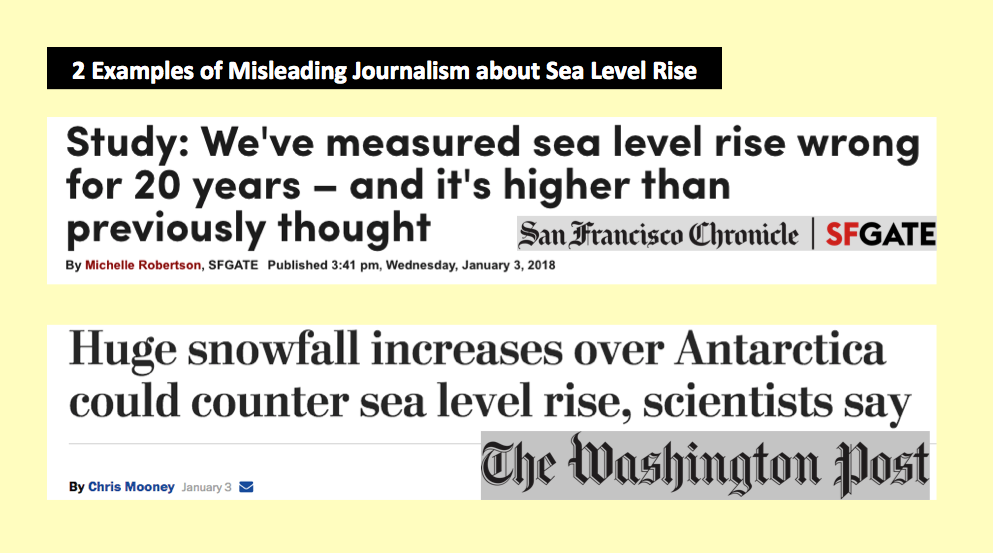Bad Journalism: The Danger of Science without Context
Even very good science can become very bad information. Good science journalism starts with good research and writing –– and then requires proper editing to convey a solid message. Headlines are written to attract and entice, but should not create false impressions. Two recent science stories deserve to be called out as examples of bad journalism, one from SF-Gate, the web version of the San Francisco Chronicle, and the other from The Washington Post. Respectively the two headlines were:
» Study: We’ve measured sea level rise wrong for 20 years – and it’s higher than previously thought
» Huge snowfall increases over Antarctica could counter sea level rise, scientists say
The SAN FRANCISCO piece describes a new finding from Delft University (Netherlands) that the seabed, or the ocean basins are actually deeper than previously thought. Therefore the measurements of the ocean height used to calculate sea level height and rise have been understated. It’s been wrong for twenty years –– higher than previously believed. Interesting. How far off you might ask. The article explains that the oceans are deeper by a tenth of a millimeter. Huh? That’s just 0.004 inches, four thousandths of an inch; less than a sheet of paper. Such an amount is meaningless in terms of public information and adds to the confusion given the headline.
THE WASHINGTON POST headline is also misleading, and more damaging in my opinion as it suggests there is a force to reduce sea level rise. The article describes that increasing snowfall on East Antartica could lock up more water on land, which effectively lowers global sea level. In principle, that’s correct. The increased snowfall is due to the warming oceans, evaporating more, which in turn comes down as heavier rain and snow. But the key question is how much sea level is at issue here? In a paragraph in the second half of the article (“Indeed, the study notes….) it says that based on the trend, by the end of the century the new understanding could LOWER global sea level by 1.5 millimeters – that’s only six hundredths of an inch!! Similar to the west coast piece, they do not give context. If it did, it would have made clear that in Antarctica with mega-glaciers melting and sliding towards the sea, that the real issue is the potential two meters (7 feet) or more of higher sea level this century. That’s several thousand times greater than the trivial amount of reduced sea level covered by this article.
These two stories add to the confusion, not clarity. Last week my blog post had a different but similar example with a terribly misleading piece in The Atlantic Magazine, “A Radical Scheme To Stop Catastrophic Sea-Level Rise.” It described an academic thesis that had not passed any practical review and was wildly naive in my view. All three of these headlines in these prominent media outlets will undermine or at least confuse officials, professionals, and the public who need to take seriously the accelerating rise of sea level that poses an unprecedented challenge to more than ten thousand coastal communities globally.
To be clear there is nothing wrong with scientists refining things down to the millimeter or tenth of a millimeter level. In fact it is essential to improve the accuracy, reconcile the sea level accounting, “balance the budgets” and make sure we are not overlooking a factor. In my opinion however, those conversations among specialists should not be spun into sensationalist misleading headlines and articles for the general public.
What’s the answer to this distorted information — epitomized by these three stories this month in mainstream media? My recommendation:
- FOR SCIENTISTS: Be extremely careful to put things in context, both in your own writing, but particularly when communicating to journalists or beyond the scientific community. Do it early in your interviews or explanations as that conveys priority and avoids it being missed by those that might not read or listen to the whole piece.
- FOR JOURNALISTS: Put science in context, early in an article, or as your profession says, “above the fold.” These articles should serve as good examples of what NOT to do.
- FOR READERS / “the public” When you are given numbers, particularly about something like sea level rise that is easily defined and visualized, try to place it in proportion or scale, to avoid being misled.
The news about record levels of heat and record melting of glaciers continues year after year. Sea level is going to be higher than most dare imagine and likely a lot sooner than even most scientists are admitting. Knowledgable experts from around the world are coming to the realization that we could have somewhere between one to three meters of higher sea level this century and perhaps even more the next. Three meters is close to ten feet.
We are facing something unprecedented and scary. All the more reason we need good, accurate journalism. Panic, denial, or false facts do no one any good. The new International Sea Level Institute will help play a role in educating the public, government personnel, and those professionals that need a thorough understanding to help us adapt. (You will be hearing more about the Institute here in the months to come.)
As we re-engineer the coastline and redesign our communities and infrastructure we need to keep our eye on the bigger picture, the meters, not the millimeters. Adapting to 3 to 10 feet of higher sea level will likely be the greatest engineering challenge this century. That would be a story worth publishing and reading.

